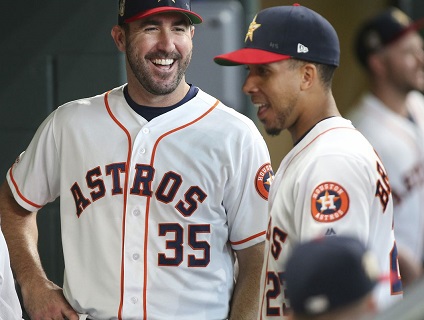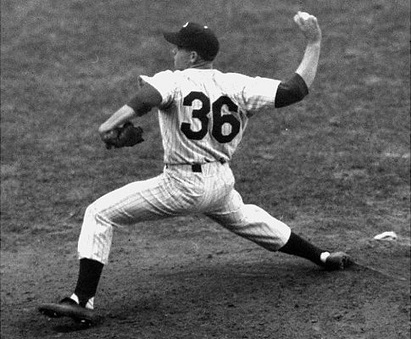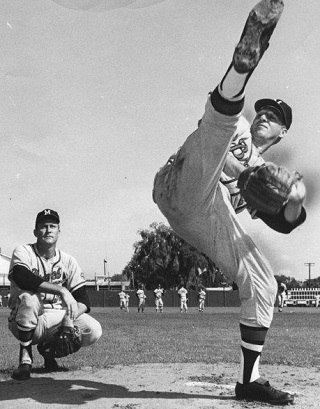
Justin Verlander shares a laugh with Michael Brantley—and you could laugh, too, if you’re surrendering lots of bombs but you’re still mostly unhittable otherwise.
There’s a reason Jayson Stark was named to the Hall of Fame as this year’s J.G. Taylor Spink Award winner. He never fails to entertain and teach at once. From the deep to the mundane, Stark finds the details that keep baseball an endless river of stimulation and delight between games and, yes, between seasons.
And sometimes it seems that only Stark—who now hangs his shingle at The Athletic, after a long and distinguished career in Philadelphia sports pages and in due course at ESPN—has the patience and the cheerful audacity to plumb into waters deep enough to be occupied only by a somehow surviving prehistoric fish.
If statistics are the life blood of baseball, then Stark is one of the game’s most valuable blood banks. When he excavates, thinking fans get behind him because they know he’s going to exhume something. Something like, say, further evidence that you shouldn’t always start anticipating the demise of a pitcher because he surrenders lots of home runs.
Not even if he’s a Hall of Famer in the making named Justin Verlander.
Stark can’t resist leading off his weekly column of uselessly useful information by noticing Verlander this season is the least hittable pitcher and the most prone to the long ball. “And if you’re thinking that’s a pretty weird combination, to give up the fewest hits but allow the most homers,” he adds, “hey, good call!”
Verlander is only the third such pitcher since 1900 to do that. And he’s in very distinguished company. Hall of Famer Walter Johnson did it in 1913, when he surrendered a measly 6.03 hits per nine average . . . and a league-leading nine home runs. (That, of course, was the final phase of the dead ball era.)
Ten years later, Yankee pitcher Bob Shawkey led the American League with an 8.06 hits-per-nine average (if that was the lowest average in the league that year, you can rest assured that high-offense eras didn’t begin in the Era of Actual or Alleged Performance-Enhancing Substances) . . . and with 17 homers surrendered.
Verlander also leads the American League this year with his 2.68 earned run average. Want to know how many league ERA champions also led in surrendering home runs the same year? Stark has the answer: two. Johnson and John Candelaria. The Big Train did it in the aforesaid 1913 season (1.14 ERA); the Candy Man led the 1977 NL with his 2.34 ERA . . . and with 29 homers surrendered.
Who would you consider the closest of today’s pitchers to Verlander’s level? His old teammate Max Scherzer, perhaps? Well, now. Scherzer through this writing has surrendered 246 home runs lifetime, averages surrendering 24 per 162 games, and his career high is the 31 he surrendered in 2016. And that didn’t stop Scherzer from winning the second of his three Cy Young Awards.
Preacher Roe, the legendary Brooklyn Dodgers lefthander who admitted upon retirement that the spitter was his money pitch, after all, once addressed his own weak hitting thus: “I do it the other way. I’ve thrown some of the longest balls in major league history.” He wasn’t far off.
Roe averaged 23 homers per 162 games lifetime and once led the National League surrendering 34 in 1950. (Even allowing the Dodgers playing in the Ebbets Field bandbox that’s a little staggering.) The NL’s ERA champion in 1950, Sal Maglie of the New York Giants, surrendered fourteen home runs the same season. Today’s baseball fan starts getting paranoid when his pitching heroes surrender a mere ten.
Hall of Famer Sandy Koufax has that five-year ERA championship streak from 1962-66 and a six-year fielding-independent pitching (ERA minus defense, essentially) streak (1961-66). His ERA over those five seasons: 1.99; his FIP over the six: 2.18. Want to know his average home runs surrendered per year over that combined span? How does 20 grab you?
Robin Roberts owned the National League from 1950-56. He finished his career surrendering one more home run (505) than fellow Hall of Famer Eddie Murray hit lifetime (504) and averaged surrendering 27 home runs per 162 games lifetime, while also having four straight years leading his league in home runs surrendered. The average per year during that streak: forty.
In year one of that streak, Roberts posted his final sub-3.00 ERA as a Phillie. The somewhat insane overwork was only beginning to catch up to him. When he helped pitch the 1950 Whiz Kids team to an unlikely NL pennant, he surrendered 29 bombs, and from 1950-53 he never surrendered less than twenty. Today’s fan would call for his head on a fence post for it.

Surrendering one more lifetime homer than Eddie Murray hit didn’t keep Robin Roberts out of the Hall of Fame . . .
Another Hall of Famer, Warren Spahn, won the second Cy Young Award, at a time when it was a major league award and not an award presented in each league. The beaky, prankish lefthander also surrendered 23 home runs that season, two above his lifetime per-162 games average. The following year, Spahn finished second in the Cy Young Award voting (the Yankees’ Bob Turley won the award)—and surrendered a career-high 29 bombs.
Just try to imagine Spahn pitching in today’s game surrendering 29 home runs in a season. Even Braves fans whose loyalty is matched by very few when it comes to their heroes might demand a public execution . . . after demanding his dispatch at the trade deadline.
Let’s look at all the Hall of Fame starting pitchers who pitched all or most of their careers in the live ball era, plus their home run proclivities, right here and now. I’ve listed them in the order of their induction, allowing that some years saw more than one such pitcher inducted:
| Pitcher | Career HR | HR/162 | Season High |
| Lefty Grove | 162 | 10 | 20 |
| Carl Hubbell | 227 | 16 | 27 |
| Dizzy Dean | 95 | 12 | 21 |
| Ted Lyons | 222 | 14 | 21 |
| Dazzy Vance | 132 | 11 | 15 |
| Bob Feller | 224 | 14 | 22 |
| Red Faber | 111 | 7 | 11 |
| Burleigh Grimes | 148 | 9 | 17 |
| Red Ruffing | 254 | 15 | 24 |
| Waite Hoyt | 154 | 10 | 16 |
| Jesse Haines | 165 | 12 | 21 |
| Lefty Gomez | 138 | 14 | 23 |
| Sandy Koufax | 204 | 20 | 27 |
| Early Wynn | 338 | 18 | 32 |
| Warren Spahn | 434 | 21 | 29 |
| Whitey Ford | 228 | 17 | 26 |
| Bob Lemon | 180 | 15 | 28 |
| Robin Roberts | 505 | 27 | 46 |
| Bob Gibson | 257 | 17 | 34 |
| Juan Marichal | 320 | 23 | 34 |
| Don Drysdale | 280 | 19 | 30 |
| Catfish Hunter | 374 | 26 | 39 |
| Jim Palmer | 303 | 19 | 26 |
| Ferguson Jenkins | 484 | 26 | 40 |
| Gaylord Perry | 399 | 18 | 34 |
| Hal Newhouser | 136 | 11 | 23 |
| Tom Seaver | 380 | 20 | 27 |
| Steve Carlton | 414 | 19 | 30 |
| Jim Bunning | 372 | 23 | 38 |
| Phil Niekro | 482 | 21 | 41 |
| Don Sutton | 472 | 21 | 38 |
| Nolan Ryan | 321 | 14 | 20 |
| Bert Blyleven | 430 | 21 | 50 |
| Tom Glavine | 356 | 18 | 24 |
| Greg Maddux | 353 | 16 | 35 |
| Randy Johnson | 411 | 23 | 32 |
| Pedro Martinez | 239 | 18 | 26 |
| John Smoltz | 288 | 16 | 23 |
| Jack Morris | 389 | 25 | 40 |
| Roy Halladay | 236 | 20 | 26 |
| Mike Mussina | 376 | 24 | 31 |

Warren Spahn, who threw a screwball and was one while he was at it, in a spring training throwing session; his rotation mate and running mate (in the practical joke department) Lew Burdette watches in a crouch.
You see five live-ball Hall of Famers surrendering 40 or more in a single season at least once (including Bert Blyleven getting circled for 50 one season); you also see fifteen such Hall of Famers surrendering 30 or more in single seasons at least once.
Make the appropriate allowances for such things as a comparatively turbocharged ball in the early 1930s, a juiced ball in the mid-1980s, and—sometimes forgotten when remembering the actual or alleged PED era—the advent of maple bats and a pack of new ballparks with retro designs and hitter friendliness in the late 1980s and 1990s.
You should still understand: Even a Hall of Famer, a no-questions-asked great among greats, even the arguable greatest peak-value pitcher of all time (Koufax), or the arguable greatest career value pitcher of all time (a possible tossup between Grove, Spahn, Seaver, and Johnson), could be and were hit for some of the longest balls in baseball history.
Think about some of the men these pitchers faced: Babe Ruth, Rogers Hornsby, Lou Gehrig, Jimmie Foxx, Ted Williams, Joe DiMaggio, Willie Mays, Mickey Mantle, Hank Aaron, Duke Snider, Ernie Banks, Frank Robinson, Dick Allen, Mike Schmidt, Ken Griffey, Jr., Jim Thome, Frank Thomas. Now, quick: What’s the flip side of the axiom that good pitching beats good hitting? And when you say that’s what Hall of Famers do, it works both ways.
So stop worrying. Learn to tolerate that your favourite pitchers, even the absolute best in the business, have learned to tolerate and shake off the bomb. And instruct any Astro fans reaching for the rye bottle whenever Justin Verlander surrenders another ball into earth orbit—lighten up. I
